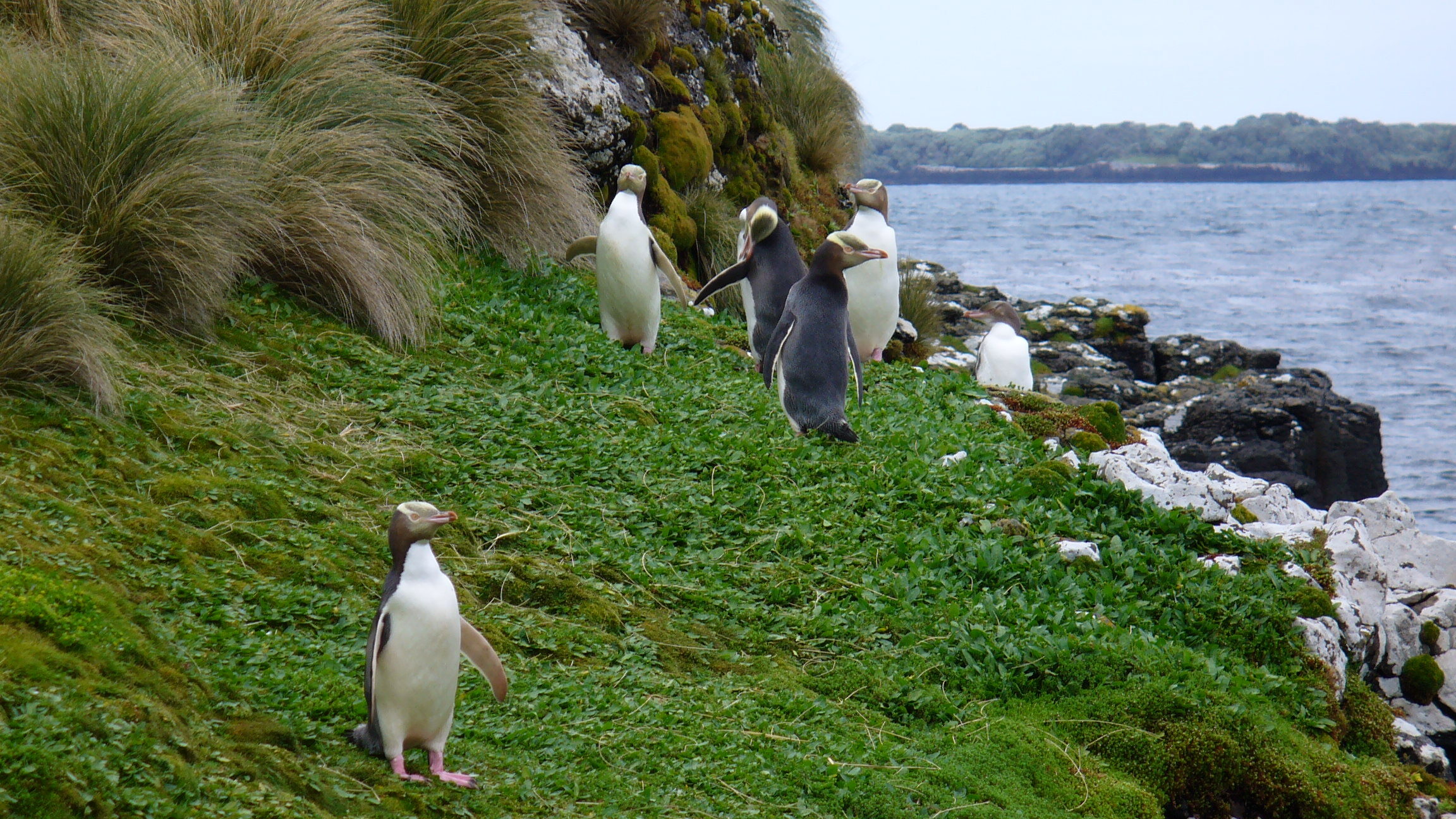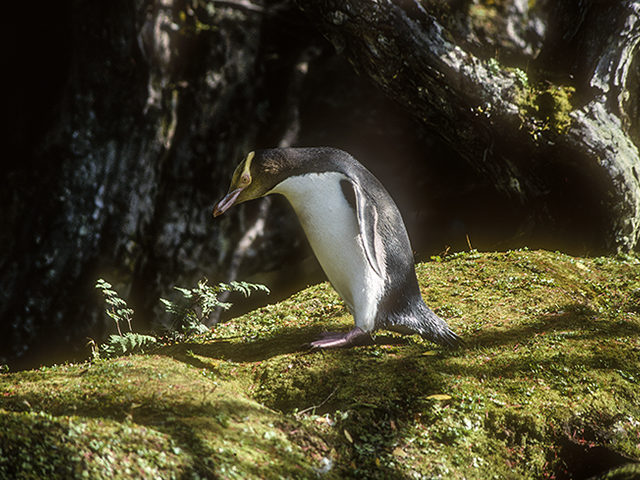Yellow-eyed penguins (YEPs) are endemic and endangered and the Otago population is declining with poor breeding seasons and high adult mortality. But YEPs live in the sub-Antarctic too. Somewhere between 37% and 49% of the total YEP breeding population are thought to breed in the Auckland Islands for example – especially on Enderby Island. So how are those penguins doing?

Researchers Chris Muller, Louise Chilvers, Rebecca French and Phil Battley (all from Massey University), along with Johanna Hiscock (Department of Conservation) report on the their recent population estimate for YEPs in the Auckland Islands in the latest volume of Notornis, the research journal of Birds New Zealand.
“The endangered yellow-eyed penguin (hōiho, Megadyptes antipodes) is endemic to New Zealand. It is highly restricted in distribution, found only in the south-east of the South Island/Te Waipounamu, Stewart Island/Rakiura and adjacent islands, and the subantarctic Auckland Islands/Motu Maha and Campbell Island/Motu Ihupuku.”

Long ago mainland New Zealand had a separate species, the Waitaha penguin (Megadyptes waitaha), which was closely related to yellow-eyed penguins, about 10% smaller in size and may (or may not) have also been yellow-eyed. It was identified as a distinctly different species as recently as 2008, using DNA evidence from ancient bones, indicating that today’s hōiho are relative newcomers to the mainland, not ancient inhabitants as previously thought.
“Extant yellow-eyed penguins recolonised mainland New Zealand from the subantarctic after the mainland species (M. waitaha) became extinct and there is currently less than 2% migration between the mainland and the subantarctic, meaning that these areas are identified as separate populations.”
Previously the subantarctic breeding areas have been identified as representing over 60% of the total YEP population – making them an important stronghold. So with mainland birds struggling and the last population estimate for the subantarctic dating back to, 1989, it was vital to collect accurate, up-to-date population information. Were the subantarctic populations facing similar struggles to the mainland penguins?
“Yellow-eyed penguins do not form colonies but nest in loose aggregations within coastal forest and scrub, with each breeding area associated with one or more access points to the sea. They prefer to nest out of sight of neighbouring birds and nests are an average of 12-32 metres and up to 78 metres apart. The nests furthest from the sea may be up to 1km inland, making them difficult to find.”
So it’s not simply a matter of finding a comfortable spot, bringing out the binoculars and sitting down to count all the birds or nests in a colony. Nesting birds have to be individually located – difficult enough when counting mainland birds and quite a challenge in the subantarctic.
“Ground-searching is the main method of nest location around mainland New Zealand, often requiring multiple search teams. Isolation and distance make the islands difficult and expensive to access and large search teams are impractical. In the Auckland Islands, yellow-eyed penguins usually nest in thick coast vegetation. This may include divaricating shrubs, which can form almost impenetrable thickets. The large area, combined with poor weather and terrain, make the New Zealand subantarctic islands a difficult environment in which to survey yellow-eyed penguins, and they can be reliably observed only when they are transiting from the forest to the sea, or vice versa.”
With manual ground-searching being less practical, previous surveys mainly used morning and evening beach counts.
“There have been no comprehensive population surveys encompassing the wider Auckland Islands area since 1989, nor an accurate measure of the relationship between recent morning counts and breeding numbers. Beach count data represent an unknown proportion of the total population, and since most yellow-eyed penguins remain in the same area year-round, the beach counts will also include an unknown proportion of non-breeding adults. To generate a reliable breeding population estimate, the survey must include direct counts of nests in at least one site (‘ground-truthing’).”
The aims of this research were to:
- determine relationships between the proportion of the yellow-eyed penguin population sighted in morning beach counts and the number of breeding adults;
- estimate the number of breeders on Enderby Island and the total breeding population for the Auckland Islands; and
- determine the ratio of breeders to non-breeders on Enderby Island, and estimate the total population for the Auckland Islands.

Morning beach counts were carried out on Enderby Island in November during 3 breeding seasons (2015-2017) along with ground-truthing – a complete census of breeding birds to identify breeding parameters. Nest searching used a variety of methods, including ground-searching and VHF radio-tracking of penguins fitted with transmitters. The penguins were tracked both on foot and by VHF-equipped drone. Ground search teams recorded nest locations using a handheld GPS.
“Morning beach counts of transiting penguins were extrapolated to estimate breeding population for the entire Auckland Island group from 2012 to 2017. Breeding numbers varied considerably between years, but overall did not appear to be declining in the short term. Breeding birds at the Auckland Islands averaged 577 pairs annually over the three ground-truthed breeding seasons, similar to the lower estimate of 520-680 pairs from the last survey in 1989, but less than the higher estimate of 650-1,009 pairs generated from that survey. Direct comparison of beach counts indicated a large decline, but these may be more prone to uncertainty.”
Large variations between years indicated variable breeding effort.
“Variable breeding success has been documented in mainland yellow-eyed penguins, and could indicate that both populations are affected by similar processes, such as the effects of climate change and food availability. However, some population crashes observed on mainland New Zealand are thought to be the result of mass adult mortality events, possibly due to disease. Such die-offs have not been observed in the subantarctic, although this may reflect infrequent monitoring.”
“The Auckland Islands (particularly Enderby Island) represent 37-49% of the total breeding population for yellow-eyed penguins, indicating the importance of the subantarctic populations for the species. We recommend ongoing monitoring, including mark-recapture methods, for future population estimates. At least 50% of the individuals in an area should be marked to reduce confidence intervals of estimates.”
The authors also recommend that long-term monitoring includes measures of breeding success as well as juvenile survival and recruitment. This is particularly important, they believe, given the population declines recently observed in mainland New Zealand.
“We have demonstrated that the subantarctic still has a large proportion of the population, and the larger population centres, such as Enderby Island, are likely to become more important for the survival of the species if populations on the mainland continue to decline. Ongoing monitoring is also needed to determine longer-term effects of changes in climate on food availability, as well as potentially catastrophic natural and unnatural events, including disease epidemics, tsunamis, and oil spills from fishing or tourist vessels.”
The full research report is published in Notornis and may be available through public libraries for non-subscribers to the journal.

